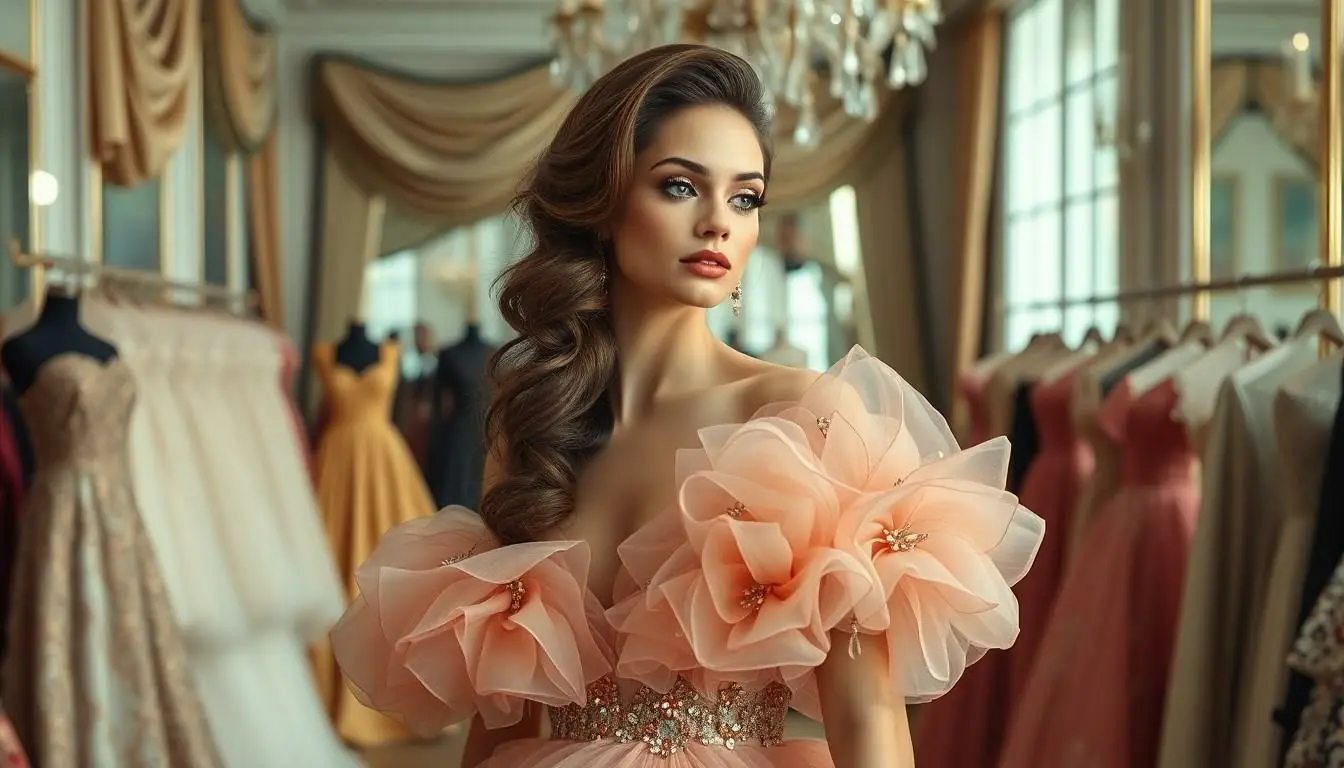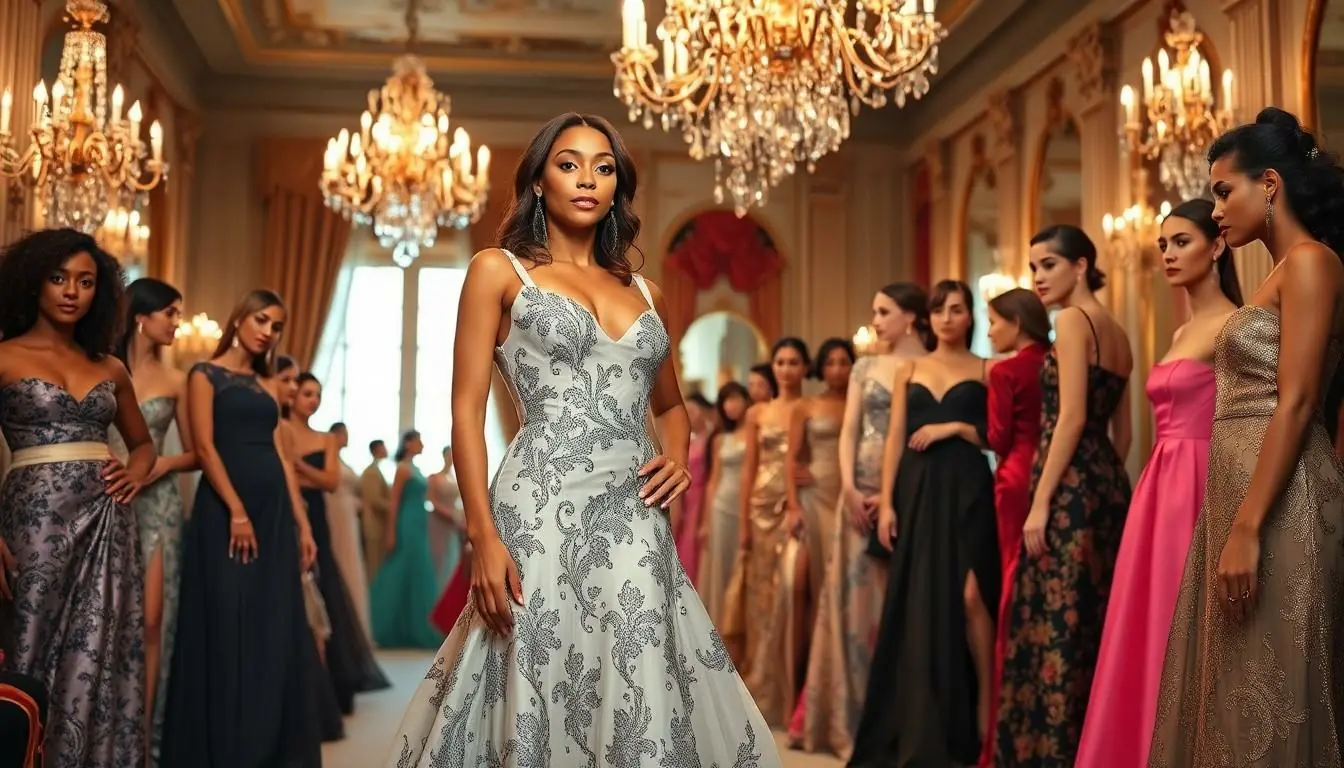Table of Contents
ToggleIn the glamorous realm of fashion, haute couture houses reign supreme, crafting exquisite garments that are more art than attire. These elite ateliers don’t just stitch fabric; they weave dreams into reality, creating pieces that make heads turn and wallets tremble. Imagine wearing a dress that’s practically a masterpiece — it’s like strutting down the street with a personal runway show, complete with gasps and applause.
But haute couture isn’t just about the clothes; it’s a lifestyle filled with luxury, creativity, and a sprinkle of whimsy. From the iconic names that have shaped fashion history to the up-and-coming talents redefining elegance, the world of haute couture is as captivating as it is exclusive. Dive into this enchanting universe where fashion meets fantasy, and discover why these houses are the ultimate destination for anyone wanting to elevate their style game to celestial heights.
Overview of Haute Couture Houses
Haute couture houses represent the pinnacle of luxury fashion. They craft custom-made garments that reflect exquisite artistry and unparalleled craftsmanship. Many of these houses possess a rich history, with some dating back over a century. Each design embodies the unique vision of its creator, elevating the fashion narrative.
Notable houses like Chanel, Dior, and Givenchy stand at the forefront. Chanel, established by Coco Chanel, revolutionized women’s fashion in the early 20th century. Dior introduced the “New Look” in 1947, emphasizing femininity and elegance. Givenchy gained fame for its timeless silhouettes and association with influential clients.
Emerging talents also contribute to the haute couture landscape. Designers like Yuima Nakazato and Iris van Herpen push boundaries, integrating innovative techniques and sustainable practices into their works. Haute couture houses often showcase their collections during Paris Fashion Week, attracting global attention and elite clientele.
The exclusive nature of haute couture means each piece commands not just a high price but also significant wait times. Typically, these garments require extensive fittings to ensure a perfect fit and personalized details. This meticulous process amplifies the allure and desirability of haute couture creations.
Artisans and seamstresses at these houses employ traditional techniques alongside modern technology. Craftsmanship remains a core value, with many designs taking hundreds of hours to complete. Haute couture’s commitment to quality, innovation, and artistic expression solidifies its status in the fashion industry.
Historical Significance of Haute Couture

Haute couture holds a prominent place in fashion history, embodying luxury, artistry, and creativity. Its influence extends beyond clothing, shaping societal norms and personal expression throughout the years.
Origins of Haute Couture
Haute couture originated in mid-19th century Paris, positioned as an elite fashion sector. English designer Charles Frederick Worth established the first haute couture house in 1858, elevating garment creation to an art form. The focus shifted to bespoke tailoring, where clients experienced luxurious materials and meticulous craftsmanship. Worth’s innovations included presenting collections in salons, introducing seasonal fashion shows that excited women about new styles. Paris soon became the epicenter for haute couture, attracting affluent clients seeking unique designs tailored exclusively for them.
Evolution Through The Decades
Haute couture evolved significantly throughout the decades. The 1920s showcased a break from traditional silhouettes, with flapper styles emphasizing comfort and freedom. The 1940s marked Dior’s “New Look,” a reaction to wartime austerity, accentuating femininity through hourglass shapes. As the years progressed, designers like Balenciaga and Versace introduced bold aesthetics and unconventional materials, pushing boundaries. In recent years, sustainability and technology took center stage, with newcomers like Iris van Herpen challenging norms through innovative techniques. Each era reflects cultural shifts and artistic experimentation, reinforcing haute couture’s status as a dynamic force in fashion history.
Key Players in the Haute Couture Industry
Haute couture thrives on creativity and exceptional craftsmanship, supported by iconic fashion houses and innovative emerging designers.
Iconic Haute Couture Houses
Chanel, one of the most recognized names, transformed women’s fashion by introducing casual elegance. Dior captured attention with its “New Look,” celebrating femininity in 1947 through voluminous skirts and cinched waists. Givenchy’s timeless designs continue to epitomize sophistication, enchanting fashion followers since the mid-20th century. Balenciaga wowed audiences with avant-garde shapes, pushing the limits of traditional fashion. Each house contributes uniquely, establishing a legacy that elevates haute couture to a level of artistry that captivates around the globe.
Emerging Designers in Haute Couture
Innovators like Yuima Nakazato showcase how modern techniques can challenge traditional boundaries. Iris van Herpen incorporates technology into designs, blending 3D printing with haute couture craftsmanship. Their works reflect sustainability and ethical considerations, reshaping viewpoints on luxury. Young talents introduce fresh perspectives, expanding the scope of the industry while maintaining its core values. Each emerging designer signifies a commitment to creativity, ensuring haute couture remains dynamic and relevant in contemporary fashion.
Craftsmanship and Techniques
Craftsmanship and techniques form the backbone of haute couture, showcasing a blend of artistry and precision. Each garment represents a labor-intensive process, highlighting the commitment to quality.
Tailoring and Construction
Tailoring distinguishes haute couture through its intricate construction methods. Experienced artisans create personalized silhouettes, ensuring a perfect fit for each client. Soft draping, hand-stitched seams, and intricate finishes contribute to the overall elegance. Techniques may include pad stitching, which adds structure, while canvas stays enhance garment longevity. Unique details like hidden pockets or custom embroidery elevate the final product, reflecting personal style and preference.
Use of Fabrics and Materials
Fabrics and materials play a crucial role in defining the luxury of haute couture. Designers often select the finest silks, wools, and lace to achieve a distinct aesthetic. Exclusive textiles, such as handwoven fabrics, represent a commitment to craftsmanship and individuality. Techniques like silk painting or digital printing allow for unique patterns and textures that stand out. Quality control ensures that materials maintain their beauty over time, making each piece not just clothing but a wearable work of art.
The Impact of Haute Couture on Fashion
Haute couture significantly shapes the fashion landscape, influencing both cultural expression and style evolution. Designers push creative boundaries while establishing trends that resonate globally.
Cultural Influence
Haute couture plays a vital role in cultural narratives, reflecting societal shifts and artistic movements. Pieces often draw inspiration from historical events, art, and cultural practices. Iconic collections encourage dialogues about femininity, identity, and social issues. For instance, Christian Dior’s New Look celebrated post-war femininity, impacting perceptions of women’s fashion. The celebration of different cultures in collections fosters appreciation and inclusivity. Consequently, haute couture extends beyond clothing, acting as a canvas for cultural representation and conversation.
Trends and Innovations
Innovation thrives in haute couture, as designers introduce groundbreaking techniques and styles regularly. Advanced materials and technologies, like 3D printing, transform traditional garment creation. Iris van Herpen exemplifies this by blending artistry with tech, producing stunning avant-garde pieces. Sustainability trends also emerge, as designers commit to ethical practices and eco-friendly materials. Yuima Nakazato showcases how innovation intertwines with responsibility, setting new standards for luxury fashion. Designers continuously evolve, ensuring that haute couture remains a dynamic force in the industry while inspiring all aspects of fashion trends.
Haute couture represents the pinnacle of fashion creativity and craftsmanship. It’s a world where artistry meets luxury, allowing designers to express their visions through exquisite garments. As trends evolve and new talents emerge, haute couture continues to inspire and challenge the boundaries of style.
The commitment to quality and personalization ensures that each piece is not just clothing but a statement of individuality and cultural expression. This realm remains a vital part of the fashion landscape, influencing trends and igniting conversations about identity and sustainability. Haute couture is more than fashion; it’s a celebration of innovation and elegance that captivates the imagination.




